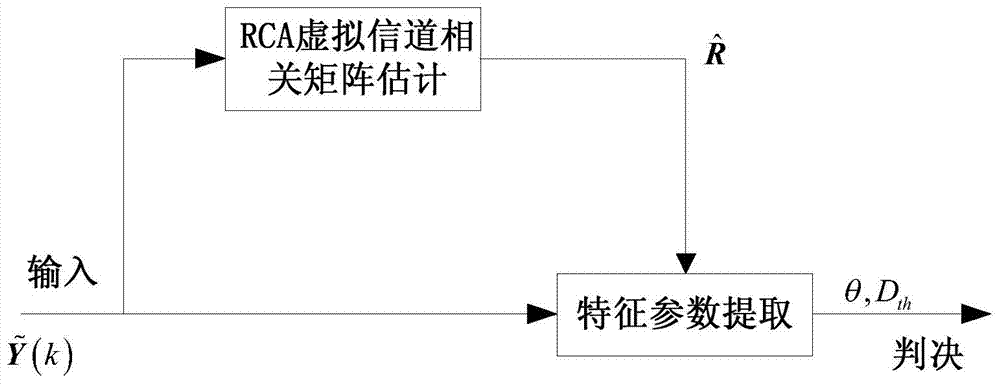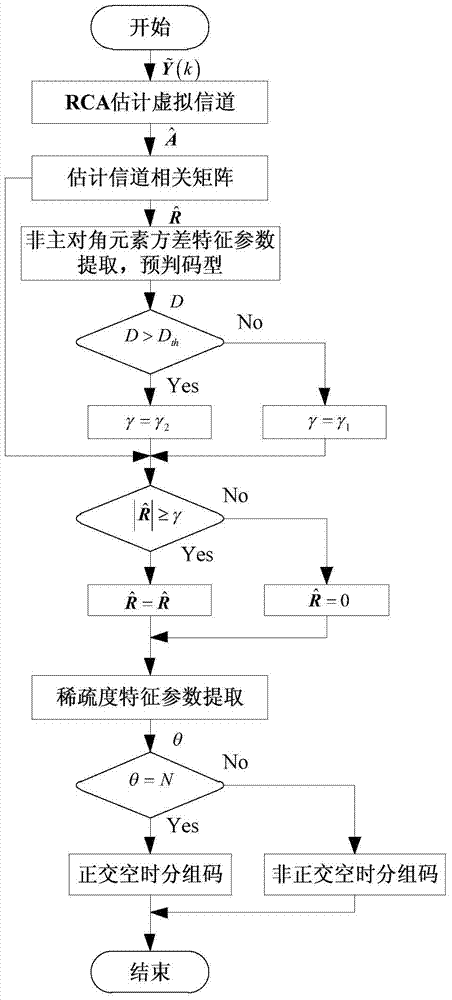Blind Identification Method of Real Orthogonal Space-Time Block Codes for Underdetermined Systems Based on Robust Competitive Clustering
A technology of robust competitive clustering and space-time block coding, applied in the field of signal processing, to improve system performance, work well, and reduce the impact of noise
- Summary
- Abstract
- Description
- Claims
- Application Information
AI Technical Summary
Problems solved by technology
Method used
Image
Examples
Embodiment 1
[0112] Embodiment 1: RCA estimation virtual channel analysis
[0113] Underdetermined systems considering insufficiently sparse signals, namely n T >n R And at each sampling moment, multiple source signals act simultaneously k≥2. In the simulation, the number of transmitting antennas n T =5, the number of receiving antennas n R =3, k=2. SNR=5dB. Perform RCA estimation virtual channel analysis.
[0114] Figure 4 -c means that the mixed signal is projected onto the upper hemisphere, take C max =50, ε=0.5 when estimating the clustering plane and mixing matrix, ε 1 = 0.0005. from Figure 5 -b It can be seen that there are 10 clustering plane potentials whose relative size exceeds 0.5, which is equivalent to 10 clustering planes, which is the number of actual clustering planes.
[0115] Using the estimated clustering planes, the source number and mixing matrix can be estimated. The relative size of the estimated mixing vector and its potential is as follows Figure 5 ...
Embodiment 2
[0121] Example 2: Estimation performance analysis of N
[0122] In the simulation, if you want to design the sparsity threshold, you must first know the number N of symbols in each group. Number of different transmit antennas n T and the number of receiving antennas n R , that is (n T , n R ), the root mean square error RMSE of the estimated value of N is respectively as Image 6 shown.
[0123] It can be seen from the figure that when SNR≥-6dB, the MDL algorithm can be used to estimate N more accurately; in the same (n T , n R ), the symbol estimation performance of the orthogonal space-time block code is better than that of the non-orthogonal space-time block code; when the transmitting antenna remains unchanged, the symbol estimation performance improves with the increase of the number of receiving antennas; when the receiving antenna remains unchanged, the As the number of transmit antennas increases, the symbol estimation performance also improves.
Embodiment 3
[0124] Embodiment 3: the impact of noise on characteristic parameters
[0125] Given that N=5, the influence of the SNR on the characteristic parameters of the orthogonal space-time block codes and non-orthogonal space-time block codes is given by Figure 7 shown.
[0126] In the figure, the D and θ values of the non-orthogonal space-time block codes are greater than the D and θ values of the orthogonal space-time block codes, and the two basically do not overlap; with the SNR transformation, the D and θ values of the orthogonal space-time block codes The θ value is basically unchanged, while the D and θ values of the non-orthogonal space-time block code are changed; when the receiving antenna is unchanged and the transmitting antenna is increased, the D and θ values of the non-orthogonal space-time block code also increase. big. in addition,
[0127] Figure 7 In -b, the same signal, the same (n T , n R ), as the SNR increases, the θ value of the non-orthogona...
PUM
 Login to View More
Login to View More Abstract
Description
Claims
Application Information
 Login to View More
Login to View More - R&D
- Intellectual Property
- Life Sciences
- Materials
- Tech Scout
- Unparalleled Data Quality
- Higher Quality Content
- 60% Fewer Hallucinations
Browse by: Latest US Patents, China's latest patents, Technical Efficacy Thesaurus, Application Domain, Technology Topic, Popular Technical Reports.
© 2025 PatSnap. All rights reserved.Legal|Privacy policy|Modern Slavery Act Transparency Statement|Sitemap|About US| Contact US: help@patsnap.com



